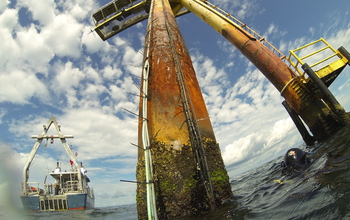New study shows changes could have major effects on global marine ecosystems
 Research vessel Tioga waits for divers. They're under the Martha's Vineyard Coastal Observatory. Credit and Larger Version |
October 20, 2016
Changes in ocean temperature affect a key species of phytoplankton, according to scientists at the Woods Hole Oceanographic Institution (WHOI) funded by the National Science Foundation (NSF).
Their study, published in this week's issue of the journal Science, tracked levels of Synechococcus -- a tiny bacterium common in marine ecosystems -- near the coast of Massachusetts over a 13-year period.
"Synechococcus and other phytoplankton are sentinels," says WHOI biologist Heidi Sosik, who initiated the study. "They tell us how an ecosystem is responding to shifts in climate."
As ocean temperatures increased during the study period, annual blooms of Synechococcus occurred up to four weeks earlier, researchers found, because cells divide faster in warmer waters. Such shifts could have major effects on marine ecosystems worldwide, according to Sosik.
If ocean temperatures continue warming over the next century, some ecosystems could become dominated by small phytoplankton, eventually leading to changes that could affect larger species like fish, whales and birds, Sosik says.
That growth in smaller phytoplankton isn't a sure thing, however.
"Now that we have the appropriate technology to study phytoplankton on time scales of hours to weeks, we're gaining a much better understanding of what controls phytoplankton populations in coastal ocean ecosystems," says David Garrison, program director in NSF's Division of Ocean Sciences, which funded the research.
Although Sosik and colleagues saw that Synechococcus cells reproduced faster than usual as conditions warmed, the overall size of the phytoplankton bloom didn't increase much during the course of the study.
As the bacteria grew more quickly, tiny protozoa, viruses and other single-celled organisms that prey on Synechococcus consumed them more quickly.
"That was a surprise to us," says Sosik. "We didn't expect such a tight lockstep among Synechococcus and its consumers as the spring bloom changed. It shows that the consumers are able to keep up."
This balance of bacteria and consumers leads to a similar bloom cycle year after year, but with a shift in timing earlier or later as the water temperature changes, Sosik says.
"The question is: How stable is that balance?" asks Kristen Hunter-Cervera, lead author of the paper and a graduate of the MIT-WHOI Joint Program in Oceanography. "In the future, will consumer species be able to keep up? A mismatch is a huge concern. If the bloom expands, or moves earlier in the year, higher-level organisms that feed on those consumers at a certain time of year might miss them entirely."
The team was able to determine division rates of Synechococcus by using an automated sensor called "FlowCytobot," developed by Sosik and WHOI colleague Rob Olson. FlowCytobot continually sampled seawater for 13 years.
The device looks for the physical characteristics of Synechococcus cells, which are roughly one micrometer in diameter and contain compounds that glow orange and red under laser light.
Using this method to tally cells has allowed the researchers to home in on just one species of phytoplankton among thousands in seawater -- the first time such a long-term experiment has been able to do so.
"Looking at physiology at the species level is a holy grail in marine ecology," Sosik says. "Each species interacts with its environment in a different way, so to understand the effects of something like temperature, it's critical to be able to study a single species. Doing that every hour, every day, every year gave us a very high-resolution picture. There's nothing like this out there."
The Gordon and Betty Moore Foundation, NASA, a National Defense Science and Engineering graduate fellowship from the U.S. Department of Defense, and WHOI also supported the work.
-NSF-
Media Contacts Cheryl Dybas, NSF, (703) 292-7734,
cdybas@nsf.gov
Stephanie Murphy, WHOI, (508) 566-3055,
Stephanie Murphy, WHOI, (508) 566-3055,
Related WebsitesNSF Grant: MRI Development: Imaging FlowCytobot on Autonomous Vehicles for Plankton Research and Harmful Algal Bloom Mitigation:
https://www.nsf.gov/awardsearch/showAward?AWD_ID=1428703&HistoricalAwards=false
Martha's Vineyard Coastal Observatory:
Martha's Vineyard Coastal Observatory:
The National Science Foundation (NSF) is an independent federal agency that supports fundamental research and education across all fields of science and engineering. In fiscal year (FY) 2016, its budget is $7.5 billion. NSF funds reach all 50 states through grants to nearly 2,000 colleges, universities and other institutions. Each year, NSF receives more than 48,000 competitive proposals for funding and makes about 12,000 new funding awards. NSF also awards about $626 million in professional and service contracts yearly.
Useful NSF Web Sites:
NSF Home Page:
https://www.nsf.govNSF Home Page:
NSF News:
https://www.nsf.gov/news/
For the News Media:
https://www.nsf.gov/news/newsroom.jsp
Science and Engineering Statistics:
https://www.nsf.gov/statistics/
Awards Searches:
https://www.nsf.gov/awardsearch/

Researcher Bennett Lambert assists with FlowCytobot at the Martha's Vineyard Coastal Observatory.
Credit and Larger Version

Divers from the Martha's Vineyard Coastal Observatory operations team return topside to the Tioga.
Credit and Larger Version

Diver's view of shipboard operations as scientist Rob Olson reaches to recover a float.
Credit and Larger Version

Researcher Kristen Hunter-Cevera uses low-tech bucket-sampling to collect seawater for analysis.
Credit and Larger Version

Scientists Rob Olson and Heidi Sosik work on the FlowCytobot automated submersible plankton sensor.
Credit and Larger Version
The National Science Foundation (NSF)
Guillermo Gonzalo Sánchez Achutegui
ayabaca@gmail.com
ayabaca@Hotmail.com
ayabaca@yahoo.com
Inscríbete en el Foro del blog y participa : A Vuelo De Un Quinde - El Foro!

No hay comentarios:
Publicar un comentario